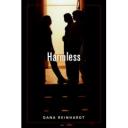 Harmless, a book that is anything but, raises some eyebrows. Do you buy it for your child? Do you put it on the shelf as a librarian? Can it be used in the classroom?
Harmless, a book that is anything but, raises some eyebrows. Do you buy it for your child? Do you put it on the shelf as a librarian? Can it be used in the classroom?
As an 8th grade Language Arts teacher I saw many heart-wrenching situations that my students wound up in, many situations that I think we as educators don’t always catch or know how to deal with. I grew up in a pretty stable environment, a fact I am thankful for, but a stable environment is not always par for the course.
What I love about Harmless is that it is told from three girls’ perspectives. Students can relate to Anna, Emma, or Mariah and their very different home environments. Because the narrator switches each chapter, there isn’t a true emphasis on one character over another. It also demonstrates to young adult readers that open communication with honesty is key to any relationship, as you are sometimes wishing one girl would just come clean to the other people to avoid confusion.
Anna and Emma have known each other since third grade. They have always been a support system for each other. When they get to high school, Mariah joins the circle. Lasting friendships are challenged as Mariah starts dating an older boy. Mariah wants to go to a party but needs Emma and Anna to come with her. Anna and Emma lie to their parents, using the excuse of going to the movies to get out of the house. Mariah is troubled that her family doesn’t ask where she’s going. When one of the girls’ moms shows up unexpectedly at the movies and doesn’t find the group, she frantically texts and calls her daughter.
To avoid getting in trouble, the girls conspire to tell their parents that the circle of girls went on a star-gazing walk when Emma was suddenly assaulted. The girls tell this story when they get home; the parents are thankful that the girls are safe, but they don’t stop there. The parents now want justice to be served for whoever attacked Emma, because it may happen again. The situation escalates as the police search for a phantom assailant and a young girl in a neighboring town goes missing.
When reading the story I was reminded of another controversial story, The Crucible by Arthur Miller. Young girls use their newfound power in society but get caught up in the lies. What is the extent of a person’s responsibility and character?
Would I use Harmless as a classroom novel? Probably in an upper-division high school class, but not at the 8th grade level. Not every single student at the 8th grade is ready for the situations, so a passing grade shouldn’t be connected to reading the book. Would I want my daughter to read it? Absolutely. A word of caution: you have to wade through Mariah’s coarse language and some very serious situations to get to the true value.
One very beneficial aspect of the book, though, is that not every consequence comes from a parent. Your parents are human; they won’t always catch you. But choices still have consequences, especially ones that you can’t see in the flurry of the immediate. I’ve had students tell me about how they’ve lied to their parents and the rough situations that they get themselves into. I would love to deal with these issues before the serious choices and consequences kick in instead of after the fact.
If one student is challenged to think twice about lying to their parents, I’m keeping the book on my shelf.
- Posted by The Tallest Librarian Ever
